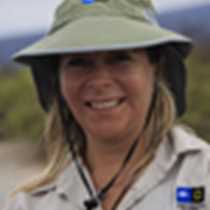Southern Isabela: Urvina Bay and Punta Moreno
Not a lot of people who come to the Galápagos get to visit this beautiful and remote area. Urvina Bay was uplifted by about four yards because of the volcanic activity in 1954 and shows vast extensions of exposed white coral and rocks with interesting marine encrustations. We found evidence of the deep water crabs, lobsters, sea turtles and other marine organisms that were trapped by uplift and could not return to the water more than fifty years ago.
Along the trail, once we had turned inland, we found magnificent, large and bright yellow male land iguanas. Over twenty of our guests took the two and a half mile long hike option. After the hike, we all enjoyed relaxing on the beach, swimming in the surf and riding waves. When we tired, we returned to the ship for a great buffet lunch.
After lunch, our expedition leader, Lynn Fowler, gave a slide presentation on her research on the giant tortoises of Volcan Alcedo and the threats that introduced mammals represent to them. After her presentation, we disembarked for the second day’s outing and visited a pristine place called Punta Moreno.
We made a dry landing and took a mile and a half hike across rough and beautiful lava flows that extended for miles in all directions. We were surprised when we came upon several small and hidden "oases". These brackish water lagoons were surrounded by green vegetation such as Scalesia, Darwinothamus, poison apple trees, and thorn bushes. In addition the lava flows were scattered with Jasminocereus and Opuntia cacti.
Those who chose the Zodiac ride as their afternoon outing motored cautiously among the breakers and exposed rocks of a low tide and found huge marine iguanas, sea lions and penguins all sharing the lava rocks. As the sun set and we returned to the ship we exalted in the golden light and a perfect end to yet another extraordinary day in paradise.
Not a lot of people who come to the Galápagos get to visit this beautiful and remote area. Urvina Bay was uplifted by about four yards because of the volcanic activity in 1954 and shows vast extensions of exposed white coral and rocks with interesting marine encrustations. We found evidence of the deep water crabs, lobsters, sea turtles and other marine organisms that were trapped by uplift and could not return to the water more than fifty years ago.
Along the trail, once we had turned inland, we found magnificent, large and bright yellow male land iguanas. Over twenty of our guests took the two and a half mile long hike option. After the hike, we all enjoyed relaxing on the beach, swimming in the surf and riding waves. When we tired, we returned to the ship for a great buffet lunch.
After lunch, our expedition leader, Lynn Fowler, gave a slide presentation on her research on the giant tortoises of Volcan Alcedo and the threats that introduced mammals represent to them. After her presentation, we disembarked for the second day’s outing and visited a pristine place called Punta Moreno.
We made a dry landing and took a mile and a half hike across rough and beautiful lava flows that extended for miles in all directions. We were surprised when we came upon several small and hidden "oases". These brackish water lagoons were surrounded by green vegetation such as Scalesia, Darwinothamus, poison apple trees, and thorn bushes. In addition the lava flows were scattered with Jasminocereus and Opuntia cacti.
Those who chose the Zodiac ride as their afternoon outing motored cautiously among the breakers and exposed rocks of a low tide and found huge marine iguanas, sea lions and penguins all sharing the lava rocks. As the sun set and we returned to the ship we exalted in the golden light and a perfect end to yet another extraordinary day in paradise.




